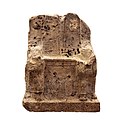| Image | Period | Location found | Current location | Inscription | Description | First published |
|---|
 | Hellenistic | Byblos | National Museum of Beirut | none | On the front, two figures pouring a libation into a flower. On the seat, rectangular anathyrosis for placing an object. [3] | Dunand [4] |
 | Hellenistic | Sidon | National Museum of Beirut | none | On the front, a Phoenician palmette. On the seat, a large rectangular mortise used to fix an object. Backrest without decoration. [3] | 1941 Dunand [5] |
 | Roman | Sidon | National Museum of Beirut | Greek inscription | Seat very tilted, unable to hold an object. The back shows a globe inside a crescent. [3] | 1924 [6] |
 | | Sidon | Louvre | none | Naiskos in which is a throne with two sphinxes. Above the seat, U-shaped cavity, intended to receive an object rounded at the bottom: perhaps a round baetyl and its crowns. On the side faces, officiating priests. [3] | 1933 [7] |
 | | Sidon | Istanbul Archaeology Museums | none | Naiskos analogous to the previous one. At the back is a small cavity, intended to hold an object. On the sides, winged goddesses of Egyptian style. [3] | [8] |
 | 2nd century BCE | Khirbet et-Tayibeh, near Ras al-Ain near Tyre | Louvre | Phoenician dedication to Astarte, known as KAI 17 | On the throne, two stelae with reliefs, depicting two standing officiants. [3] | 1907 Ronzevalle [9] [10] [11] |
 | Hellenistic | Ain Baal near Tyre | National Museum of Beirut | none | Seat contains a stele or baetyl [3] | |
 | Hellenistic | Region of Tyre | National Museum of Beirut | none | Seat contains a stele or baetyl [3] | |
 | 4th century BCE | Umm al-Amad | Louvre | none | On the front, a Phoenician palmette [3] | 1860, Renan [12] |
 | | Umm al-Amad | National Museum of Beirut | none | The front is broken. Horizontal seat, rounded front. Backrest without decoration. Large throne which could fit a person. [3] | Dunand |
 | | Temple of Eshmun | Temple of Eshmun | none | | Dunand |
 | | Temple of Eshmun | National Museum of Beirut | none | | Dunand |
 | Hellenistic | Unknown | National Museum of Beirut | none | | |
















